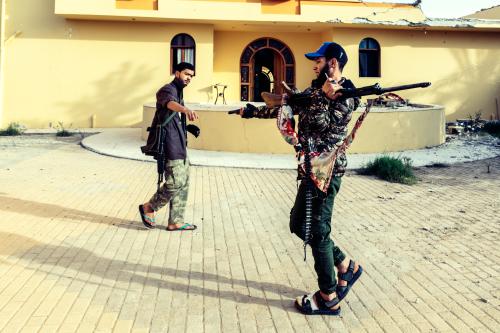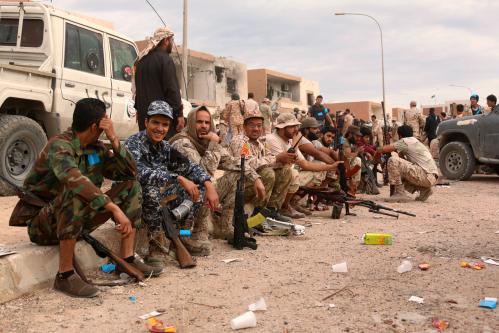Outside powers have long picked sides in the Middle East. Today, there is—rightly—lots of attention on the proxy war elements of the Syrian conflict, with Russia and its allies supporting the Bashar Assad regime on the one hand, and the United States and its allies supporting a number of rebel groups on the other. But a similar dynamic—admittedly with less carnage—may be playing out in Libya, too, and it tends to be less understood. Who is Russia supporting in Libya, and why? And how did it get that way?
The Gadhafi years
Throughout the 1970s, it became increasingly clear to Libyan leader Moammar Gadhafi that developments in his region were not trending in his favor. For one, Libya’s relations with neighboring Egypt deteriorated seriously: Rumors spread that Libya was secretly funding the Muslim Brotherhood’s military wing to stage attacks in Egypt, and Egyptian President Anwar Sadat would bitterly attack “the madman of Libya” in speeches (Gadhafi, in return, dubbed Sadat the “servant of the Americans”). Moreover, after a period of intense mediation by U.S. Secretary of State Henry Kissinger, Egypt and Israel further strengthened ties, signing the Sinai Interim Agreement (Sinai II) in 1975.
Gadhafi, perceiving a growing American offensive in the Middle East, approached the Soviet Union in 1976. Libya was already one of the Kremlin’s best customers in heavy industry purchases, and Gadhafi signed contracts to bring about a thousand Soviet engineers and military instructors to Libya in order to build new and more modern missile bases. That was the beginning of a close and long-lasting friendship: Over the next decade or so, more than 11,000 Russian soldiers appeared on Libyan soil and, according to some sources, participated side by side with Gadhafi’s army in various conflicts. Many Libyan officials, in turn, were sent to the Soviet Union for specialized courses (a similar system to what was implemented in the pro-Soviet Afghanistan during the 1970s).
Gadhafi’s visits to Moscow dropped off in 1985 (during an era when the country was becoming more reclusive generally, in part related to new Western sanctions), and it wasn’t until 23 years later—in 2008—that he returned. What explained the new outreach? In short, Russia’s Vladimir Putin—then newly the prime minister for the second time—was willing to cancel $4.5 billion in debts that Libya accrued during Soviet times in exchange for favorable Russia-Libya trade agreements. The deals were estimated to be worth $5 to $10 billion and would include weapons sales and a contract for the construction of a rail link between Sirte and Benghazi by Russian Railways. The railway contract alone was worth almost $2.2 billion. Russia was also in search of strategic bases on the Mediterranean, and Gadhafi granted Moscow access to the port of Benghazi for its fleet. Gadhafi never got along well with Washington, and he saw having a Russian settlement on his territory as a good deterrent against American meddling.
So you say you want a revolution
When there was a revolution in Libya in 2011, Russia was one of the staunchest critics of the NATO military intervention. Although Russia did not veto U.N. Security Council Resolution 1973, which formed the legal basis for that intervention, it took many weeks for Moscow to side in favor of the Libyan National Transitional Council (and even then, only after rebel factions assured Russian leaders that they would respect all Gadhafi-era contracts with the country). But U.N. sanctions against Tripoli had already taken a huge toll on Russia: It lost more than $4 billion due to, for example, the cancellation (a few days before the resolution was implemented) of a 600-million euro contract for the supply of anti-missile systems, as well as the indefinite postponement of the agreement for Russian Railways to build a Sirte-Benghazi high-speed railway.
In the revolution’s aftermath, the Kremlin feared that Libya would become much more pro-Western. So Russia updated its strategy.
At Russia’s invitation, Tobruk-based Prime Minister Abdullah al-Thani (who was at that time the internationally recognized leader of the country) traveled to Moscow in April 2015 to relaunch bilateral relations, officially interrupted after the Gadhafi regime’s collapse. He reminded Moscow that it had billions of dollars in investments in Libya, some implemented by Gazprom and its affiliates for oil and gas exploration and production.
But a series of agreements brought a different government—the Government of National Accord (GNA), backed by the United Nations—to power in Tripoli, weakening al-Thani’s government (which was backed by General Khalifa Haftar and his militia, the Libyan National Army). Amid a political stalemate today, little has changed: Libya is still divided into two governments, with rival factions fighting regionally and at a local level. It’s a war of all against all—and meanwhile, the economic and social situation is collapsing.
Russian rationale
Where does Russia fit in today’s Libya picture? One answer is weapons supply: Although the U.N. has put in effect an arms embargo, weapons still appear to circulate smoothly—many believe that’s largely because Russia is bypassing the embargo to support the Tobruk-based government. Another answer is military advising more generally: This July, for instance, Haftar flew to Moscow (making a pitstop in Cairo, too) for an unofficial visit. He met with Russian Minister of Defense Sergei Shigou, Deputy Foreign Minister Igor Morgulov Nikolai Patrushev, and Putin’s personal advisor.
Also, Russia is literally printing some of Libya’s money: In May, new banknotes to the tune of 4 billion dinars (nearly $3 billion) were printed in Russia for the al-Beida branch of the Central Bank of Libya, despite protests from the central branch of Tripoli and the international community. The move, not surprisingly, didn’t solve Libya’s liquidity problem and has only made the country’s banking system less credible.
So Russia—along with Egypt and the United Arab Emirates—maintains the facade that it supports the GNA (and, by extension, the coveted goal of Libyan unity), but continues to be the most important supporter of Haftar and the Tobruk-based government in general. Without approval from Tobruk, Russian Foreign Minister Sergey Lavrov has stressed, the U.N.-and U.S.-backed GNA is not legitimate.
The full rationale for Russia’s support of Libya’s Tobruk-based government is fairly nebulous. (Egypt’s, in contrast, seems to be quite readable: Cairo wants to limit the scope of the Muslim Brotherhood in Libya, control the movements of Salafi terrorist groups, and expand its influence on the always-coveted Cyrenaica). It’s unlikely that the Kremlin is only interested in increasing its armaments market—rather, having a central role in Libya’s reconstruction, both politically and economically, is the real prize. After years of war, Libya is in a rough place and needs nearly complete rebuilding, not only at a social and political level, but also in terms of infrastructure (roads, railways, cities). Although it’s been in decline for years, the exploitation of oil and gas in Libya has enormous potential. Not to mention that a willing government could guarantee the use of the eastern Libyan ports of Sirte and Benghazi on the Mediterranean. For Russia, which is continuing to expand its presence in the Eastern Mediterranean (specifically in Syria), this opportunities are a potential strategic gold mine.







Commentary
Russia and Libya: A brief history of an on-again-off-again friendship
September 1, 2016